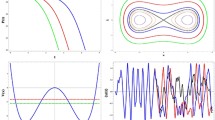Abstract
With aid of the so-called dilation method, a concise formula is obtained for the entropy production in the algebraic formulation of quantum dynamical systems. In this framework, the initial ergodic state of an external force system plays a pivotal role in generating dissipativity as a conditional expectation. The physical meaning of van Hove limit is clarified through the scale-changing transformation to control transitions between microscopic and macroscopic levels. It plays a crucial role in realizing the macroscopic stationarity in the presence of microscopic fluctuations as well as in the transition from non-Markovian (groupoid) dynamics to Markovian dissipative processes of state changes. The extension of the formalism to cases with spatial and internal inhomogeneity is indicated in the light of the groupoid dynamical systems and noncommutative integration theory.
Similar content being viewed by others
References
R. Kubo,J. Phys. Soc. Japan 12:570 (1957).
N. G. van Kampen,Phys. Norveg. 5:279 (1971).
R. Kubo, M. Toda, and N. Hashitsume,Statistical Physics, Vol. 2 (Springer-Verlag, Berlin, 1985).
I. Ojima, H. Hasegawa, and M. Ichiyanagi,J. Stat. Phys. 50:633 (1988).
I. Ojima, inQuantum Field Theory, F. Mancini, ed. (Elsevier, 1986), p. 443; inProceedings 2nd International Symposium Foundations of Quantum Mechanics (Tokyo, 1986), M. Namikiet al., eds. (Physical Society of Japan, Tokyo, 1987), p. 91.
J. Lebowitz,Phys. Rev. 114:1192 (1959); H. Hasegawa, T. Nakagomi, M. Mabuchi, and K. Kondo,J. Stat. Phys. 23:281 (1980).
T. Masuda,Publ. RIMS Kyoto Univ. 20:929, 959 (1984).
A. Connes, inLecture Notes in Mathematics, No. 725 (Springer-Verlag, Berlin, 1979), p. 19; J. Renault,Lecture Notes in Mathematics, No. 793 (Springer-Verlag, Berlin, 1980); J. Bellissard and D. Testard, preprint CPT-81/P.1311 (1981).
M. E. Mayer, inDifferential Geometrical Methods in Theoretical Physics, K. Bleuler, ed. (D. Reidel, Dordrecht, 1988).
R. Haag, N. M. Hugenholtz, and M. Winnink,Commun. Math. Phys. 5:215 (1967).
O. Bratteli and D. W. Robinson,Operator Algebras and Quantum Statistical Mechanics, Vol. 2 (Springer-Verlag, Berlin, 1981).
M. Ichiyanagi,J. Phys. Soc. Japan 55:2093 (1986).
H. Araki,Publ. RIMS, Kyoto Univ. 11:809 (1976);13:173 (1979); A. Uhlmann,Commun. Math. Phys. 54:21 (1977).
K. Yosida,Functional Analysis, 6th ed. (Springer-Verlag, Berlin, 1980).
J. Avron and B. Simon,Commun. Math. Phys. 82:101 (1981); J. Bellissard, R. Lima, and D. Testard, inMathematics + Physics: Lectres on Recent Results, Vol. 1, L. Streit, ed. (World Scientific, Singapore, 1985), and references cited therein.
N. Dunford and J. T. Schwartz,Linear Operators, Vol. I (Wiley-Interscience, New York, 1958); N. Bourbaki,Éléments de Mathématique, Espaces Vectoriels Topologiques, 2nd ed. (Hermann, Paris, 1966).
J. Bellissard, private communication (1987); C. Rickart,General Theory of Banach Algebras (Van Nostrand, New York, 1960).
J. Bellissard, private communication (1987); J. S. Howland,Math. Ann. 207:315 (1974); K. Yajima,J. Math. Soc. Japan 29:729 (1977).
L. van Hove,Physica 21:517 (1955).
L. van Hove,Physica 23:441 (1957).
E. B. Davies,Commun. Math. Phys. 39:91 (1974);Math. Ann. 219:147 (1976);Ann. Inst. Henri Poincaré 11:265 (1975).
V. Gorini, A. Frigerio, M. Verri, A. Kossakowski, and E. C. G. Sudarshan,Rep. Math. Phys. 13:149 (1978), and references cited therein.
K. Hepp and E. Lieb,Helv. Phys. Acta 46:573 (1973).
G. Mackey,Proc. Natl. Acad. Sci. USA 50:1184 (1963);Math. Ann. 166:187 (1966).
A. Connes,Proc. Symp. Pure Math. 38(Part 1):521 (1982).
J. Bellissard, inLecture Notes in Physics, No. 257 (Springer-Verlag, Berlin, 1986), p. 99.
M. Berry,Proc. R. Soc. Lond. A 392:45 (1984); B. Simon,Phys. Rev. Lett. 51:2167 (1983); P. Nelson and L. Alvarez-Gaumé,Commun. Math. Phys. 99:103 (1985).
R. L. Hudson and K. R. Parthasarathy,Commun. Math. Phys. 93:301 (1984); G. Parisi and Y.-S. Wu,Sci. Sin. 24:483 (1981); J. R. Klauder,Acta Phys. Austr. Suppl. XXV:251 (Springer-Verlag, Berlin, 1983); M. Namiki, inProceedings 2nd International Symposium Foundations of Quantum Mechanics (Tokyo, 1986), M. Namikiet al., eds. (Physical Society of Japan, Tokyo, 1987), p. 333.
Author information
Authors and Affiliations
Rights and permissions
About this article
Cite this article
Ojima, I. Entropy production and nonequilibrium stationarity in quantum dynamical systems. Physical meaning of van Hove limit. J Stat Phys 56, 203–226 (1989). https://doi.org/10.1007/BF01044241
Received:
Revised:
Issue Date:
DOI: https://doi.org/10.1007/BF01044241




